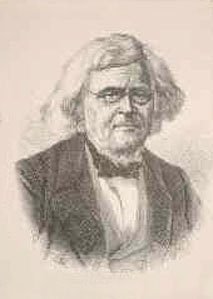| Peter Andreas Hansen  Born: 8-Dec-1795 Born: 8-Dec-1795
Birthplace: Tondern, Denmark
Died: 28-Mar-1874
Location of death: Gotha, Germany
Cause of death: unspecified
Gender: Male
Race or Ethnicity: White
Occupation: Astronomer Nationality: Denmark
Executive summary: Fundamenta nova investigationis Danish astronomer, born on the 8th of December 1795 at Tondern, in the duchy of Schleswig. The son of a goldsmith, he learned the trade of a watchmaker at Flensburg, and exercised it at Berlin and Tondern, 1818-20. He had, however, long been a student of science; and Dr. Dircks, a physician practicing at Tondern, prevailed with his father to send him in 1820 to Copenhagen, where he won the patronage of H. C. Schumacher, and attracted the personal notice of King Frederick VI. The Danish survey was then in progress, and he acted as Schumacher's assistant in work connected with it, chiefly at the new observatory of Altona, 1821-25. From there he passed on to Gotha as director of the Seeberg observatory; nor could he be tempted to relinquish the post by successive invitations to replace Friedrich Georg Wilhelm Struve at Dorpat in 1829, and Friedrich Wilhelm Bessel at Königsberg in 1847. The problems of gravitational astronomy engaged the chief part of Hansen's attention. A research into the mutual perturbations of Jupiter and Saturn secured for him the prize of the Berlin Academy in 1830, and a memoir on cometary disturbances was crowned by the Paris Academy in 1850. In 1838 he published a revision of the lunar theory, entitled Fundamenta nova investigationis, etc., and the improved Tables of the Moon based upon it were printed in 1857, at the expense of the British government, their merit being further recognized by a grant of £1000, and by their immediate adoption in the Nautical Almanac, and other Ephemerides. A theoretical discussion of the disturbances embodied in them (still familiarly known to lunar experts as the Darlegung) appeared in the Abhandlungen of the Saxon Academy of Sciences in 1862-64. Hansen twice visited England and was twice (in 1842 and 1860) the recipient of the Royal Astronomical Society's gold medal. He communicated to that society in 1847 an able paper on a long-period lunar inequality (Memoirs Roy. Astr. Society, XVI, 465), and in 1854 one on the moon's figure, advocating the mistaken hypothesis of its deformation by a huge elevation directed towards the earth (XXIV, 29). He was awarded the Copley medal by the Royal Society in 1850, and his Solar Tables, compiled with the assistance of Christian Olufsen, appeared in 1854. Hansen gave in 1854 the first intimation that the accepted distance of the sun was too great by some millions of miles (Month. Notices Roy. Astr. Soc., XV, 9), the error of Johann Franz Encke's result having been rendered evident through his investigation of a lunar inequality. He died on the 28th of March 1874, at the new observatory in the town of Gotha, erected under his care in 1857. Royal Astronomical Society Gold Medal 1842
Royal Astronomical Society Gold Medal 1860
Copley Medal 1850
Do you know something we don't?
Submit a correction or make a comment about this profile
Copyright ©2019 Soylent Communications
|